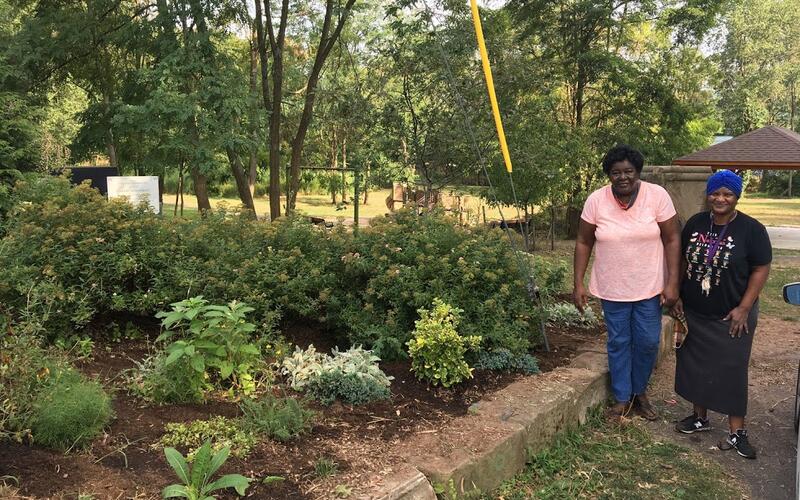Striving for Equity in Parks
Cherry Ann Park leader Connie Vereen (on left) with her neighbor
In 2014 Cherry Ann Park did not have a single amenity. There were no signs, benches, trash cans, or playground equipment before Ms. Connie Vereen approached URI with her vision to create a safe place for her neighborhood’s children to play. Mainly used as a dumping site, this squalid 4.75-acre park surrounded by Black and Brown residents was a clear environmental injustice. Ms. Connie lobbied the City for nearly a decade to install a playground before she connected with URI. Through a variety of funders, the park now contains two playgrounds, trash bins and signs (City funded), three benches (donated by Yale School of the Environment [YSE] students), and a splashpad and pavilion (both supported by a very generous YSE alumna). Matching those contributions, Ms. Connie and co-leader Mike Rich rallied the neighborhood children to clear debris, remove invasive plants, put in flowerbeds and trees and maintain them. This Community Greenspace success story is an exemplar of URI’s mission of responding to community-identified priorities.
URI champions this model of planting “for New Haven residents, by New Haven residents.” In our green-job training, the GreenSkills program, URI only plants trees where residents request and commit to watering trees. Our Community Greenspace program is similarly based on responding to neighbors who identify where they wish to plant and steward land.
Although we are dedicated to this community-driven model, we recognize that unfortunately there are parks that do not have a leader like Ms. Connie with the passion, commitment, time, and energy to support them. When The Trust for Public Land (TPL) invited URI to collaborate on conducting an analysis of New Haven’s park system, we saw this as an opportunity to better understand the limits of our community-led model, and potentially reveal environmental inequities we have not yet sought to address.
TPL’s ParkScore Index is a tool used annually to rank the park systems of 100 of the most populated cities in the U.S. New Haven is the smallest city to have completed the ParkScore analysis in the country, and the first in Connecticut. URI is primarily interested in the distribution of park resources throughout New Haven. TPL hopes to conduct ParkScore analyses in other Connecticut cities in order to understand the needs and opportunities of urban park systems statewide.
To help assess park-system quality, TPL’s ParkScore analysis inventories six types of amenities chosen to appeal to a diverse range of multigenerational users. Staying true to URI’s mission, before embarking on ParkScore we sought input from Greenspace park-friend volunteer leaders to ensure the survey reflected their priorities. Input by community leaders and City staff, who also were interested in obtaining a more robust inventory of the parks system, resulted in adding 14 amenities to inventory. URI intern Regina Sung surveyed 136 publicly accessible greenspaces including all of the City’s parks documenting the existence and condition of the 20 amenity types, often with help from park-friend leaders.
A few highlights of our inventory analysis (soon to be published on URI and TPL websites) include:
• Amenities: New Haven scored 71/100 points with 76 playgrounds, 71 basketball courts, 14 splashpads, 5 recreation centers, 4 dog parks, and notably just 2 permanent public restrooms.
• Investment: New Haven scores in the lower 35th percentile compared with the 100 most populated cities in America. The City spent an average of $77 per capita on parks in the three years preceding 2020.
• Access: New Haven ranked high with 96% of residents living within a 10-minute walk of a park.
• Acreage: Despite 1,409 acres of park land (12% of the City), with several large destination parks, New Haven scored low (36/100) due to the small median size (1.53 acres).
• Equity: TPL found, “When comparing park space per person, neighborhoods of color have 47% less than white neighborhoods, and low-income neighborhoods have 47% less than high-income neighborhoods.”
Beyond New Haven’s ranking compared to other cities, we also learned the condition and distribution of the parks. For instance, the Hill neighborhood has just 21 acres of park land for its 15,500 people (majority people of color) compared to the East Shore with over 220 acres, but only 4,500 people (majority white). While Lighthouse Point Park and other East Shore parks are destinations for all New Haven, this comparison and disparity explain the TPL finding of less than half the amount of park land per capita for communities of color.
ParkScore makes clear the need to invest in the Hill community. Our survey revealed the Hill’s largest park, Kimberly Field (10.9 acres), has dilapidated baseball dugouts, broken basketball hoops, persistent flooding, and hazardous litter. Fortunately, leaders at the adjacent middle school are enthusiastic about the idea of renovating the park, and Athletic Brewing has provided seed money to install a trail. Our aim is to hold community meetings, and through that process, optimistically, a park volunteer may decide to lead the way forward. In partnership with the City, volunteers, and donors, Kimberly Field could be transformed as Cherry Ann Park was into a destination.
The ParkScore project was made possible by a grant from the Greater New Haven Green Fund (http://www.gnhgreenfund.org/). We are grateful for its support and for the Fund’s efforts to realize its mission of engaging and empowering citizens to help create clean, healthy, and environmentally sustainable communities.
